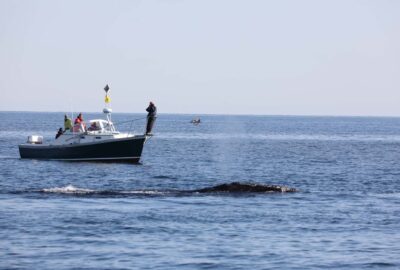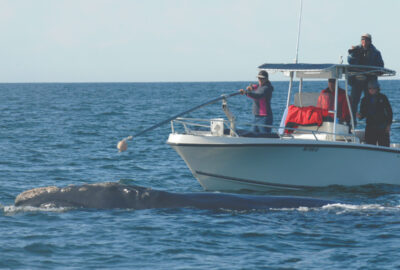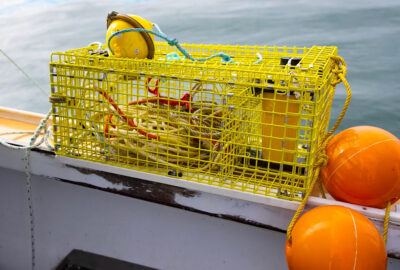New Study Finds Vessel Speed Restrictions Essential to Protecting Large Whales
By New England Aquarium on Wednesday, January 24, 2024

New England Aquarium-led research recently published in the journal Biological Conservation reinforces the importance of a 10-knot speed limit for vessels (meaning all ships, boats, and other craft on the water) and that where and when vessels need to slow down is important. Speed limits can help protect whale species, including the endangered North Atlantic right, humpback, fin, and sei whales. These species have been injured or killed by vessel strikes throughout their range along the East Coast, including most recently a right whale calf observed earlier this month with severe propeller injuries to its head.

Understanding the impact of vessel strikes can be challenging because vessel strikes can prove fatal for whales and collisions between vessels and whales often go undetected, unreported, or underreported. In the paper, researchers assessed potential vessel-strike risk reductions for these whales and found that expanding a 10-knot speed restriction would reduce risk. The research supports studies that have found the current speed restriction areas are too small (Schick et al., 2009; van der Hoop et al., 2015). It shows that speed restrictions are not needed in all U.S. East Coast waters, but they are needed in larger areas and longer time periods to cover important whale habitat.
To conduct this study, researchers developed a metric for assessing risk that incorporates the relationship between vessel speed and the probability that a strike is deadly, the distance a vessel travels, and whale habitat use. Then, they calculated risk reductions based on speed restrictions of 14, 12, and 10 knots and the effect of implementing these restrictions for the entire U.S. East Coast Exclusive Economic Zone (ranging from the northern boundary of Maine to the southern tip of Florida, extending 200 nautical miles from the coastline) versus regions containing higher whale densities.
Currently, reducing vessel strike risk often involves route changes and slower speeds. Changing routes, or determining areas to be avoided, helps lessen the simultaneous presence of whales and vessels and speed restrictions help reduce the risk of fatalities. Studies have found that the faster a vessel travels, the higher the probability of a fatal strike. Plus, slower speeds could allow whales and/or vessel operators more time to take actions to avoid a collision.
Conservation groups such as the Aquarium have been researching and working to mitigate vessel strike risk for decades, and there has been progress. In 2008, Seasonal and Dynamic Management Areas were implemented by the National Oceanic and Atmospheric Administration (NOAA) along the U.S. East Coast to protect North Atlantic right whales, an endangered species with less than 360 individuals estimated remaining. Seasonal Management Areas were established where the risk of a vessel striking a right whale is expected to be higher due to whale or vessel traffic density. Analyses of right whales struck within Seasonal Management Areas (Laist et al., 2014) and analyses comparing the number of right whales struck before and after management measures were implemented (NOAA, 2020) suggest that these measures have helped to reduce vessel strikes of right whales. However, even one mortality or serious injury to a right whale from vessel strikes is inconsistent with United States law and the best available science. Even one human-caused mortality puts the species at risk of extinction. From 2008 through January 2024 in the United States, there were 14 documented known or potentially lethal vessel strikes, which suggests that further action is required to support the recovery of the species by reducing vessel strike risk. At least five of these strikes involved vessels smaller than 65 feet, which are not subject to the mandatory speed restrictions. NOAA is currently considering modifications to the existing vessel speed rule to better protect North Atlantic right whales. Proposed changes to the rule include expanding the size of and time period for areas with seasonal speed restrictions, extending restrictions to most vessels measuring 35 to 65 feet in length, and implementing mandatory speed restrictions in dynamic speed zones, which are established when whales are observed.
Scientists at the New England Aquarium’s Anderson Cabot Center for Ocean Life have done extensive research for thirty years to determine the frequency and location of right whale vessel strikes, identify the type and size of the vessels involved, and assess the impacts vessel strike injuries have on the health of this species at the individual and population levels. This research presents a new metric for estimating reductions in vessel-strike risk, especially in areas where less information about large whale species is available. It has important applications on the United States East Coast: it shows that the proposed expansion of the speed restriction areas in the vessel strike rule will help protect right whales, and that other large whale species would also benefit from expanding these areas.
References
- Laist, D.W., Knowlton, A.R., Pendleton, D., 2014. Effectiveness of mandatory vessel speed limits for protecting North Atlantic right whales. Endanger. Species Res. 23, 133–147.
- NOAA, 2020. North Atlantic Right Whale (Eubalaena glacialis) Vessel Speed Rule Assessment. Office of Protected Resources.
- Schick, R.S., Halpin, P.N., Read, A.J., Slay, C.K., Kraus, S.D., Mate, B.R., et al. (2009). Striking the right balance in right whale conservation. Canadian Journal of Fisheries and Aquatic Sciences 66(9), 1399-1403. doi: 10.1139/f09-115.
- van der Hoop, J.M., Vanderlaan, A.S.M., Cole, T.V.N., Henry, A.G., Hall, L., Mase-Guthrie, B., et al. (2015). Vessel strikes to large whales before and after the 2008 ship strike rule. Conservation Letters 8(1), 24-32. doi: 10.1111/conl.12105.




